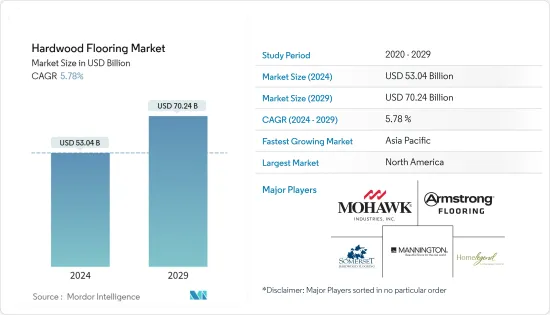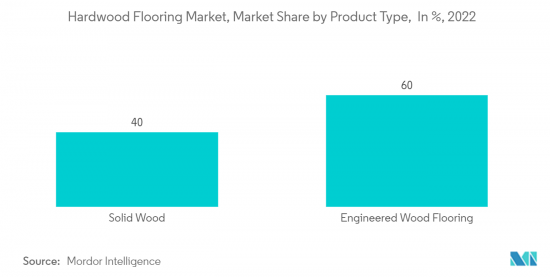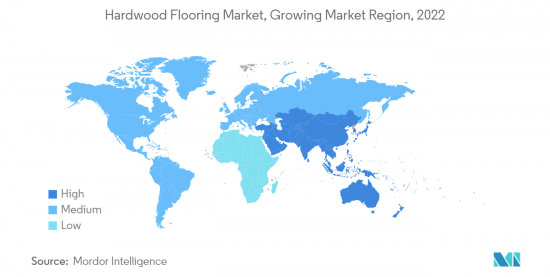
|
市場調査レポート
商品コード
1430593
ハードウッドフローリング:市場シェア分析、産業動向と統計、成長予測(2024年~2029年)Hardwood Flooring - Market Share Analysis, Industry Trends & Statistics, Growth Forecasts (2024 - 2029) |
||||||
カスタマイズ可能
適宜更新あり
|
|||||||
| ハードウッドフローリング:市場シェア分析、産業動向と統計、成長予測(2024年~2029年) |
|
出版日: 2024年02月15日
発行: Mordor Intelligence
ページ情報: 英文 150 Pages
納期: 2~3営業日
|
全表示
- 概要
- 目次
2024年のハードウッドフローリング市場規模は530億4,000万米ドルと推定され、2029年には702億4,000万米ドルに達すると予測され、予測期間中(2024-2029年)のCAGRは5.78%で成長する見込みです。

ハードウッドフローリング市場はここ数年安定的に成長しており、今後も継続すると予想されます。ハードウッドフローリングの需要を牽引しているのは、住宅や商業施設の建設活動の増加、環境に優しく持続可能なオプションへの需要の高まり、美観に優れたフローリングソリューションへの嗜好の高まりです。
アジア太平洋地域はハードウッドフローリングの最大市場であり、中国とインドが成長に大きく貢献しています。同地域は、急速な都市化、可処分所得の増加、中産階級の人口増加を背景に、今後も市場を独占し続けると予想されます。北米と欧州もハードウッドフローリングの重要な市場であり、米国は北米最大の市場です。欧州では、ドイツ、英国、フランスがハードウッドフローリングの主要市場です。
COVID-19は、2020年のハードウッドフローリング製造市場の大規模な抑制要因となりました。貿易制限によりサプライチェーンが寸断され、世界各国の政府による封鎖措置により消費が減少しました。ロックダウンは住宅や建築プロジェクトの建設を制限し、ハードウッドフローリングの新規購入を制限しました。状況の変化と顧客のパンデミックに対するアプローチにより、市場は予測期間中に回復すると予想されます。
ハードウッドフローリング市場の動向
最大の人工木材セグメント
人工木材はコンクリートやハードウッドの代替品として適しているため、予測期間中も需要は高水準で推移すると予想されます。建築家、建設業者、法律関係者、設計者は、人工木材製品を広く使用しています。彼らはまた、エネルギーを節約し、建設を迅速化し、人件費を削減し、廃棄物を削減するエネルギー効率の良い農法についても知っています。
北米と欧州では可処分所得が高く、国民の間に人工木材の利点が広く認識されているため、この分野はより高いペースで推移すると予想されます。人工木材床部門は、今年度の総収入の中で大きなシェアを占めています。人工木材製品の利点の1つは、エンドユーザーの需要やカスタム仕様に合わせて設計できることです。メンテナンスの容易さやカラフルなデザインの独自性なども、同分野の成長を後押ししています。

アジア太平洋地域が最も高い成長率を予測
アジア太平洋地域は急成長している市場であり、予測期間中も大幅な成長が見込まれます。この成長を牽引しているのは、急速な都市化とそれに伴う住宅・不動産開発、豊かで美しく豪華なデザインの熱帯木材フローリングへの嗜好、手頃な価格の人工木材フローリングソリューションの発売、中間層の拡大とフローリング装飾に対する意識の変化などです。この地域は、マホガニー、チーク、黒檀、ローズウッドなど、熱帯雨林や湿潤な広葉樹林に生育する熱帯木材で有名です。

ハードウッドフローリング産業の概要
本レポートでは、ハードウッドフローリング市場で事業を展開する主要な国際企業を取り上げています。市場シェアの面では、現在、少数の大手企業が市場を独占しています。しかし、技術の進歩や製品の革新に伴い、中堅から中小の企業が新規契約の獲得や新市場の開拓によって市場での存在感を高めています。
その他の特典:
- エクセル形式の市場予測(ME)シート
- 3ヶ月間のアナリスト・サポート
目次
第1章 イントロダクション
- 調査の成果 と市場定義
- 調査範囲
第2章 調査手法
第3章 エグゼクティブサマリー
第4章 市場力学
- 市場概要
- 市場促進要因
- 市場抑制要因
- バリューチェーン/サプライチェーン分析
- ポーターのファイブフォース分析
- 供給企業の交渉力
- 買い手/消費者の交渉力
- 新規参入業者の脅威
- 代替品の脅威
- 競争企業間の敵対関係の強さ
- 業界の技術進歩に関する洞察
- COVID-19の市場への影響
第5章 市場セグメンテーション
- 製品タイプ
- 無垢材
- レッドオーク
- ホワイトオーク
- メープル
- その他の無垢材
- エンジニアードウッド
- 無垢材
- エンドユーザー
- 住宅用
- 商業用
- 流通チャネル
- オフライン店舗
- オンラインストア
- 地域
- 北米
- 欧州
- アジア太平洋
- 南米
- 中東・アフリカ
第6章 競合情勢
- 市場集中の概要
- 企業プロファイル
- Mohawk Industries
- The Armstrong Flooring, Inc.
- Mannington Mills, Inc.
- Home Legend, LLC
- Somerset Hardwood Flooring
- Provenza Floors, Inc.
- Beaulieu International Group
- BerryAlloc
- Classen
- Egger
- Formica*
第7章 市場機会と今後の動向
第8章 免責事項
The Hardwood Flooring Market size is estimated at USD 53.04 billion in 2024, and is expected to reach USD 70.24 billion by 2029, growing at a CAGR of 5.78% during the forecast period (2024-2029).

The hardwood flooring market is growing steadily for the past few years and is expected to continue in the coming years. The demand for hardwood flooring is driven by increasing residential and commercial construction activities, rising demand for eco-friendly and sustainable options, and a growing preference for aesthetically pleasing flooring solutions.
The Asia-Pacific region is the largest market for hardwood flooring, with China and India being the major contributors to growth. The region is expected to continue to dominate the market, driven by rapid urbanization, increasing disposable incomes, and a growing middle-class population. North America and Europe are also significant markets for hardwood flooring, with the United States being the largest market in North America. Europe, Germany, the UK, and France are the major markets for hardwood flooring.
The Coronavirus disease (COVID-19) was a massive restraint on the hardwood flooring manufacturing market in 2020. Supply chains were disrupted due to trade restrictions, and consumption declined due to lockdowns imposed by governments globally. The lockdown restricted the construction of housing and building projects and limited the new purchase of hardwood flooring. Due to the changed situations and customers ' approach towards the pandemic, the market is anticipated to bounce back during the forecast period.
Hardwood Flooring Market Trends
Largest Engineered Wood Segment
Demand for engineered wood is expected to remain high during the forecast period, as it is an apt alternative to concrete and hardwood. Architects, builders, code officials, and designers widely use engineered wood products. They also know about energy-efficient farming practices that conserve energy, speed up construction, cut labor costs, and reduce waste.
The segment is expected to move at a higher pace in North America and Europe, owing to high disposable income and widespread awareness of the benefits of engineered wood among the populace. The engineered wood floor segment contributed a large share of the total revenue in the current year. One of the advantages of engineered wood products is that they can be designed per the end-user's demand and custom specifications. Easy maintenance and the uniqueness of colorful design are among other features pushing the segment's growth.

Asia-Pacific is Anticipated to Grow at the Highest Rate
Asia-Pacific ranks as the fastest-growing market, with a significant growth rate likely to be witnessed over the forecast period. This growth is led by rapid urbanization and resulting housing and real estate development, preference for tropical wood flooring in rich, beautiful, and luxurious designs, the launch of affordable engineered wood flooring solutions, and expanding middle class and their changing attitude toward flooring decors. The region is famous for tropical wood growing in rainforests and moist broadleaf forests such as mahogany, teak, ebony, and rosewood.

Hardwood Flooring Industry Overview
The report covers major international players operating in the hardwood flooring market. In terms of market share, few of the major players currently dominate the market. However, with technological advancement and product innovation, mid-size to smaller companies are increasing their market presence by securing new contracts and tapping new markets.
Additional Benefits:
- The market estimate (ME) sheet in Excel format
- 3 months of analyst support
TABLE OF CONTENTS
1 INTRODUCTION
- 1.1 Study Deliverables and Market Definition
- 1.2 Scope of the Study
2 RESEARCH METHODOLOGY
3 EXECUTIVE SUMMARY
4 MARKET DYNAMICS
- 4.1 Market Overview
- 4.2 Market Drivers
- 4.3 Market Restraints
- 4.4 Value Chain / Supply Chain Analysis
- 4.5 Porter's Five Forces Analysis
- 4.5.1 Bargaining Power of Suppliers
- 4.5.2 Bargaining Power of Buyers/Consumers
- 4.5.3 Threat of New Entrants
- 4.5.4 Threat of Substitute Products
- 4.5.5 Intensity of Competitive Rivalry
- 4.6 Insights on Technological Advancements in the Industry
- 4.7 Impact of COVID-19 on the market
5 MARKET SEGMENTATION
- 5.1 Product Type
- 5.1.1 Solid Wood
- 5.1.1.1 Red Oak
- 5.1.1.2 White Oak
- 5.1.1.3 Maple
- 5.1.1.4 Other Solid Woods
- 5.1.2 Engineered Wood
- 5.1.1 Solid Wood
- 5.2 End-User Type
- 5.2.1 Residential
- 5.2.2 Commercial
- 5.3 Distribution Channel
- 5.3.1 Offline Stores
- 5.3.2 Online Stores
- 5.4 Geography
- 5.4.1 North America
- 5.4.2 Europe
- 5.4.3 Asia-Pacific
- 5.4.4 South America
- 5.4.5 Middle East & Africa
6 COMPETITIVE LANDSCAPE
- 6.1 Market Concentration Overview
- 6.2 Company Profiles
- 6.2.1 Mohawk Industries
- 6.2.2 The Armstrong Flooring, Inc.
- 6.2.3 Mannington Mills, Inc.
- 6.2.4 Home Legend, LLC
- 6.2.5 Somerset Hardwood Flooring
- 6.2.6 Provenza Floors, Inc.
- 6.2.7 Beaulieu International Group
- 6.2.8 BerryAlloc
- 6.2.9 Classen
- 6.2.10 Egger
- 6.2.11 Formica*


